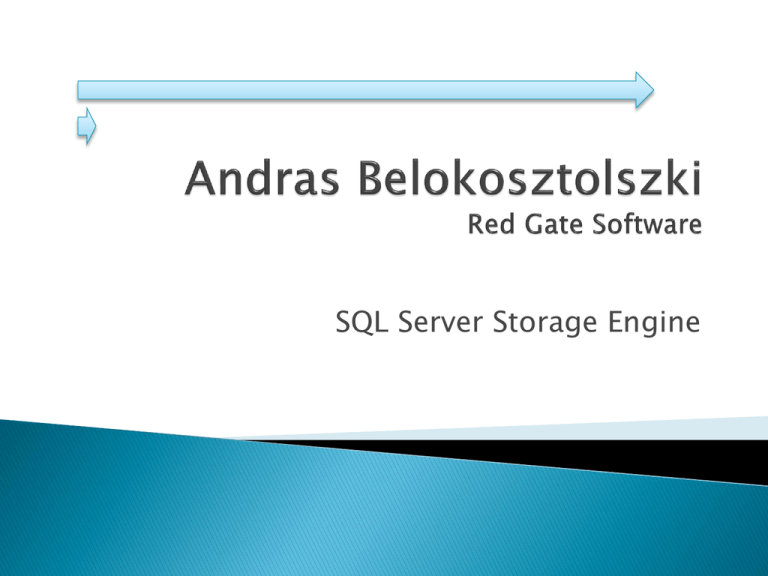SQL Server Storage Engine
advertisement

SQL Server Storage Engine Software architect at Red Gate Software Responsible for SQL tools: ◦ ◦ ◦ ◦ SQL Compare, SQL Data Compare, SQL Packager SQL Log Rescue SQL Refactor … many others Events (NxtGenUG, VBUG, SQL Bits, PASS, many other user groups) SQL Server Central Blog: http://www.simple-talk.com/community/blogs/andras/default.aspx Articles: http://www.simple-talk.com/author/andr%c3%a1s-belokosztolszki/ Physical storage ◦ Pages, rows, data types, index structure Data and schema modifications ◦ What happens when you change the schema ◦ What happens when a row is inserted, delted, etc SQL Server 2008 features ◦ Compression and file streams Primary database file (*.mdf) Secondary database files (*.ndf) ◦ Optional, can be more than one Log files (not covered) Primary Database Secondary Secondar y Log Log Data files are dividied up into 8KB pages All information is stored in pages (data, schema, database information, space allocation(GAM, SGAM, IAM), dlls) Identified by fileId:PageId (2+4 bytes) 8 pages = 1 extent Most important for us is the data page 1:0 1:1 1:2 1:3 1:4 1:5 1:6 1:7 1:8 1:9 1:A 1:B 1:C 1:D 1:E 1:F Page header (96 bytes) Data rows Offset array DBCC PAGE ◦ (db,file,page,options) 2 – raw, 3 – row details ◦ Trace flag 3604 Demo Page header Stat A (1) Stat B (1) Null offset (2) Fixed Length Data Colum n Count (2) Null bitmap Ceiling(ColCnt/ 8) VarLen Colum n Count (2) Var. Offsets VarLen Data Fixed length data will always use its allocated space (even when it is null) Must fit a page (max 8060 bytes) Demo ◦ Some items can overflow: Overflow space See sys.types ◦ Fixed length (some can be adjusted (time, decimal, char(), …) Always consumes this space ◦ ◦ ◦ ◦ Variable length (varchar, varbinary, …) Bit (packed) SqlVariant Binary large objects (ntext, varchar(max), …) After a certain size stored on other pages Heap/Index 1 sys.indexes N Partition sys.partitions sys.partitions sp JOIN sys.allocation_units au ON sp.partition_id = au.container_id 1 3 Allocation Unit sys.allocation_uni ts In row data LOB Row overflow Root level Interior levels Level 0 Leaf level Row Data The full row record is at the leaf level ◦ Consequently there can be only one clustered index In the intermediary and root levels a clustered key is stored, for the first entries of the next level pages If the key row length is e.g. 15 bytes, an intermediary page can store up to (8096/15 =) 539 rows (reference 539 pages) Exact space usage in sys.allocation_units Pages are double linked Root level/ Interior levels Leaf level Row Data See sys.allocation_units Max 900 bytes per entry! Index entry contains the key columns, and ◦ Index key columns ◦ Record locator (nonclusered) Row ID or clustering key (not stored redundantly) ◦ Down pointer (for non leaf pages) Stat A (1) Fixed Length Data Colum n Count (2) Null bitmap Ceiling(ColCnt/8 ) VarLen Colum n Count (2) Var. Offsets VarLen Data Motivation: ◦ When using a clustered index on heap, an item is looked up, then one more page read to retrieve extra data ◦ When using a clustered index on a B-tree, the clustered index structure is also traversed You can include extra columns in a nonclustered index These will not be used to look up rows in the table Increases the coverage of an index Increases the size of an index record -> the total size Extra maintenance Everything is stored on pages Rows have fixed and variable length portions ◦ Differences between certain data types and their limitations Index structures ◦ Size estimates for indexes, page estimates for queries The fewer pages we load into memory, the better? Schema changes Data changes • Adding a column • Inserting a row • Changing a column • Deleting a row • Dropping a column • Altering a row ◦ What can happen: No rows are modified, only meta information All rows are examined E.g. changing nullability Int to smallint (wasted space!) All rows are rebuilt ◦ We may end up wasting a lot of valueable space! How can we reclaim the space? Demo Insert: added where there is space Delete: removed or marked as ghost Update: Since indexes refer to file:page:slot if a row no longer fits on a page, it cannot easily be moved -> it is moved, but a reference to it is left (forwarded record) Insert: Since the rows are ordered, if there is not enough space on a table, the table is split into two (can happen many times) Update: ◦ like inserts, if the new row is too big to fit ◦ Changes to clustering columns = delete+insert Delete: the row is marked as ghost or is deleted Pad Index •Intermediary pages only •Specified as percentage Fill Factor •Leaf pages only •Specified as percentage Only when index is created or rebuilt. The free space is NOT maintained. (see later index reorganization and rebuilding) sys.dm_db_index_physical_stats() Logical fragmentation: next leaf page for index page is not the next page that is allocated to the index Extent fragmentation: extents are not contiguous Page fill Drop and create the clustered index ◦ Index is offline ALTER INDEX REORGANIZE ◦ This is the replacement for DBCC INDEXDEFRAG ◦ Reorganizes index pages (and compacts pages and LOBs) (NO new pages) ALTER INDEX REBUILD ◦ This is the replacement for DBCC DBREINDEX ◦ Basically drops and recreates the index Introduced in SQL Server 2008 Stores fixed length data as variable length ◦ E.g. Integer – can use 1,2,3,4 bytes + bits instead of 4 bytes + bit CREATE TABLE RowCompressedTable (…) Available in Enterprise edition WITH (DATA_COMPRESSION = Row); Stat A (1) Colum n Count (1/2) CD Array (4b/co l) Short data Null bitmap Ceiling(ColCnt/ 8) VarLen Colum n Count (2) Var. Offsets VarLen Data CD Array: 0 = null, 1 – 9 number of bytes, 10 – long Self contained WITH (data_compression = row) Row compression Prefix compression Dictionary compression When table created, there is no compression Row compression kicks in when otherwise a page split would occur When table with data converted it is rebuilt sp_estimate_data_compression_savings Page header Page header aaabcc aaaacc abcd aaabb aaaab abcd 4b 4b [] aaabcc bbbb abcd [] 0bbbb [] aaaccc aaaacc bbbb 3ccc [] 0bbbb Page header aaabcc aaaacc Page header abcd aaabcc aaaacc 4b 0bbbb abcd 4b 4b [] 0 0 [] [] 0bbbb [] [] 1 [] 3ccc [] 0bbbb 3ccc [] 1 B-tree structure Many pages need to be looked up Smaller BLOBs can be inlined sp_tableoption <tablename>, ‘text in row’, <length> Data row Text Pointer Root entry Intermediate node Data fragment Data fragment Intermediate node Data fragment Data fragment When BLOBs are not enough: ◦ Large items (over 1Mb) ◦ Very fast read is needed ◦ 2GB++ Can use T-SQL to access File stream access vie Win32 API Static data storage ◦ Table and index rows ◦ The way these are linked together What happens during schema and data modifications Lessons to take away ◦ Minimize the number of pages you need to read or write ◦ Rebuild your tables and use fill factor, and rebuild indexes durng off peak hours! ◦ Use the specialized data types and storage options Thanks to SQL Bits & Sponsors Blog: http://www.simpletalk.com/community/blogs/andras/default. aspx Email: Andras.Belokosztolszki (at) redgate.com







